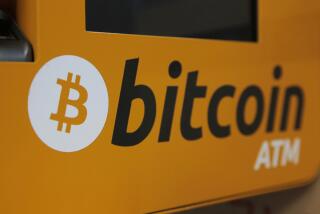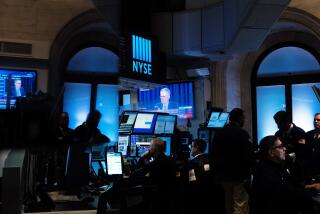VIEWPOINTS : Trading in Your Broker for a Machine
- Share via
At a time when computerized program trading is a favored bete noire in explaining the market’s Oct. 19 debacle, it may come as a surprise to suggest that another form of computerized trading may be a partial remedy for excessive market volatility. Nonetheless, the securities industry could benefit from an innovation in communications technology that already is used widely in banking--the automated teller machine, or ATM.
Using this technology, stock market investors could place orders to buy or sell securities from what might be called automated broker machines, or ABMs, located at brokers’ offices and at many other convenient locations, just as ATMs are. Eventually, many investors even could place their orders from their computers at home. (In fact, a small but apparently growing number of institutional and individual investors already trade securities using personal computers at work or home.)
No Commissions
Why would this improve the way the stock market works? Largely because it would help brokerage firms change how they take in revenue from individual investors. Now brokers charge customers each time they trade a stock. By introducing ABM technology, however, securities firms instead could charge fixed monthly or yearly fees to all customers having access to the computerized trading systems.
That, in turn, could have a major effect on the securities business: By eliminating trading commissions, it would take away much of the incentive brokers now have to encourage frequent buying and selling of securities. And that sort of trading spurs volatility in the stock market.
On the other hand, market volatility poses hazards for brokerage firms. If prices are “too” volatile over “too” long a period, investors might liquidate their holdings and move their assets elsewhere. Even so, it is doubtful that concerns about this phenomenon actually offset the attractions of market volatility. In addition, fee-cutting competition among brokerage firms reduces, but doesn’t eliminate, the incentive to encourage trading or general market volatility.
The incentive brokerage firms have to foster trading volume may have far-reaching effects. Where market indicators are ambiguous, brokers usually will embrace factors that point to an upward or downward market rather than a stable one. Brokers clearly prefer rising markets to falling ones because they benefit from higher stock prices as well as higher trading volumes. But the most important thing is lots of trading, either on the way up or down. Even in the October crash, the anguish to securities firms was relieved by the threefold or fourfold jump in trading volume, which boosted commissions.
This is not to say that the crash was “engineered” by Wall Street. There were several precipitating economic forces at work: an increase in interest rates and the prospect of further increases; a growing possibility of inflation as a result of the declining exchange value of the dollar, and the unprecedentedly high price-to-earnings ratio for stocks among other reasons. Still, the interest that securities firms have in generating trading is worrisome. Consequently, efforts that would eliminate the incentive to stir up markets--by establishing an automated broker machine network as well as other measures--are warranted.
Dangers Minimized
So how would a system of automated broker machines work? To begin with, brokers would charge customers who use the systems the same sort of service fees that telephone companies charge. And as with many banks’ ATM services, the charge would be the same regardless of how often you use it. To be fair to long-term investors who rarely trade their securities, however, a lower charge, analogous to the custodial fee currently on IRA accounts, could be levied.
The dangers of trading by computer could be minimized. The computer system itself could scan an investor’s securities portfolio, cash holdings, allowable credit and the standard suitability rules, based on data maintained by the brokers. No appreciable expansion of current record-keeping would be necessary, and the computer programming required to perform the necessary screening would be simple and inexpensive. As with ATMs, an automated broker machine system could be implemented by the industry itself, perhaps with encouragement from the Securities and Exchange Commission and the major stock exchanges.
To be sure, the automated broker machine system would have drawbacks. Because it would eliminate transaction charges, the machines actually might encourage trading that otherwise wouldn’t have taken place. Also, as with ATMs, the system might present computer security and privacy problems.
But even though the amounts involved in automated broker machine transactions would be larger, it would be harder to pull off a theft. If you crack an ATM’s security system, you walk way with the money in the machine. With an automated broker machine, however, the asset involved in a transaction remains in the custody of a brokerage house.
Just as the “T” in ATM reduces the demand for bank tellers, so the “B” in ABM would reduce the demand for brokers. Instead, though, there might be more demand for computer programmers, and brokers could work primarily as analysts, consultants and advisers instead of as sales personnel. In the process, the incentives created by brokerage commissions to promote market volatility would be curtailed.
More to Read
Inside the business of entertainment
The Wide Shot brings you news, analysis and insights on everything from streaming wars to production — and what it all means for the future.
You may occasionally receive promotional content from the Los Angeles Times.










